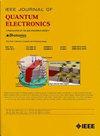A Nanoplasmonic Directional Coupler Utilizing a Backed Conductor on Dielectric Substrate With Finite Width
IF 2.1
3区 工程技术
Q3 ENGINEERING, ELECTRICAL & ELECTRONIC
引用次数: 0
Abstract
A new nanoplasmonic directional coupler (DC) is proposed, utilizing a conductor-backed coplanar waveguide (CPW) with a finite width. Our design approach includes first establishing a theoretical transmission-line model for the coupler, and then utilizing the characteristic parameters of related coupled CPW structures for a comprehensive analysis. The provided analysis is conducted through full-wave analysis using a conformal mapping technique (CMT), implemented in CST Microwave Studio Suite CAD simulation software. This article primarily focuses on designing and analyzing the directional coupler using a backed conductor on the dielectric substrate with finite width, applying the transmission line (TL) theory method to achieve a coupling coefficient (利用有限宽度介质基底上的背衬导体的纳米光导定向耦合器
我们提出了一种新型纳米光子定向耦合器 (DC),它利用了宽度有限的导体支撑共面波导 (CPW)。我们的设计方法包括首先建立耦合器的理论传输线模型,然后利用相关耦合 CPW 结构的特征参数进行综合分析。所提供的分析是通过保形映射技术 (CMT) 进行的全波分析,该技术是在 CST Microwave Studio Suite CAD 仿真软件中实现的。本文主要侧重于设计和分析使用有限宽度介质基板上的背衬导体的定向耦合器,并应用传输线(TL)理论方法实现 3 分贝的耦合系数($C_{C}$)。所提出的等离子体耦合器可在 O 波段和 L 波段的光学频率下高效工作。仿真结果表明,通过改变背向导体的宽度($w_{c}$),可有效调节定向耦合器的耦合系数。因此,所提出的设计超越了传统窄带耦合器的性能,为亚波长无线网络和高密度纳米级光子集成电路(PIC)的应用提供了显著优势。
本文章由计算机程序翻译,如有差异,请以英文原文为准。
求助全文
约1分钟内获得全文
求助全文
来源期刊

IEEE Journal of Quantum Electronics
工程技术-工程:电子与电气
CiteScore
4.70
自引率
4.00%
发文量
99
审稿时长
3.0 months
期刊介绍:
The IEEE Journal of Quantum Electronics is dedicated to the publication of manuscripts reporting novel experimental or theoretical results in the broad field of the science and technology of quantum electronics. The Journal comprises original contributions, both regular papers and letters, describing significant advances in the understanding of quantum electronics phenomena or the demonstration of new devices, systems, or applications. Manuscripts reporting new developments in systems and applications must emphasize quantum electronics principles or devices. The scope of JQE encompasses the generation, propagation, detection, and application of coherent electromagnetic radiation having wavelengths below one millimeter (i.e., in the submillimeter, infrared, visible, ultraviolet, etc., regions). Whether the focus of a manuscript is a quantum-electronic device or phenomenon, the critical factor in the editorial review of a manuscript is the potential impact of the results presented on continuing research in the field or on advancing the technological base of quantum electronics.
 求助内容:
求助内容: 应助结果提醒方式:
应助结果提醒方式:


